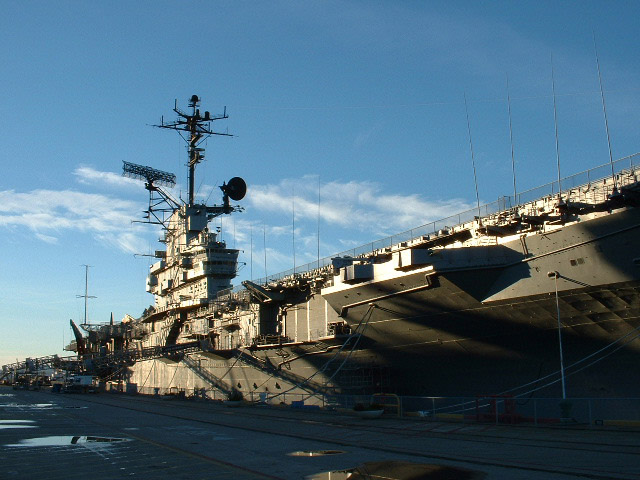USS HORNET CV12/CVA12/CVS12

Hornet
belonged to the Essex Class and was the seventh one to be commissioned.
Keel was laid on August 3 1943 at the Newport News Shipyard as the
Kearsarge. Launch was on August 30 and then moved to the fitting out
pier. On November 29 the Hornet was officially commissioned by
Secretary Knox. Sea trials commenced on December 19. Her original
displacement was 27, 100 tons and when fully loaded 36,200 tons. Her
overall length was 876.8 feet and beam was 147.5 feet overall. Her
height, which includes the designed draft of 29.5 feet, is 223.0 feet
to the top of the mast. Steam is provided by eight Babcock and Wilcox
boilers divided among four fire rooms. Propulsion is handled by four
Westinghouse geared turbines in two engine rooms which provide 150,000
shaft horsepower. Top speed is 33 knots and upon her retirement she
could still steam at 31 knots. Armament consisted of four twin mount
5-inch/38 caliber gun turrets located two in front and two behind the
island. Four single mount were located on sponsons on the port side
Gallery deck. There were 32, later 40, Bofors 40mm mounts and 46, later
55, 20mm mounts. Today there are only four single mount 5-inch/38 cal.
guns left on the ship.
She arrived in the Pacific war zone on
March 20 1944 and her air group scored their first Zero on March 29.
She was at sea for 15 continuous months before being caught in a
massive typhoon which damaged 40 feet of the forward flight deck on
June 3 1945. She headed back to Hunters Point Naval Shipyard for
repairs and was there when the war ended. She became one of the Navy's
most decorated combat seips and holds the record for the number of
enemy ships and aircraft destroyed during WWII. She was also under
attack 59 times without a hit being scored although she had a near miss
in October 1944 off Okinawa. Unlike the Franklin the Japanese plane
failed to release it's bomb onto a fully loaded flight deck and instead
it landed harmlessly off to the port side.
After
decommissioning from 1947-51 she was brought back to service and
modernized three times. Between 1953-58 she was classified an attack
carrier at which point newer carriers were being commissioned. Since
she still had hydraulic catapults, unlike some of her sisters, she was
then classified as an Anti-Submarine Warfare Carrier. In her final
years she saw service off Vietnam and was the primary recovery ship for
the first two moon landings of Apollo 11 and 12. She was then
decommissioned in June 1970 and stored in Bremerton. She managed to
escape being scapped till 1997 when a group formed to save the ship and
dock her at the former Alameda Naval Air Station. She joined Intrepid,
Yorktown and Lexington as the only four Essex Class carriers left
today. As a volunteer, who walked on in May 1998, it has been a
priviledge to restore this ship for the American people who own this
historic carrier. Special recognition goes to former quartermaster Rolf
Saybe, former signal man Jim Yuschenkoff and former seabee Tom McNanama
whose knowledge helps in getting things restored correctly. Last, all volunteers and docents deserve thanks as without them there would be no Hornet Museum.
Attention:
Now that the museums long term COO has retired, thankfully, we are able
to move forward with plane and ship restoration. Anyone who contacted
that COO in the past about naval or military donations, and was turned
down, please feel free to contact me via the web site or Rick Thom at
the USS Hornet.
Home | Ship | Aircraft | The Past | Museum | Suisun Reserve Fleet | Webmaster
